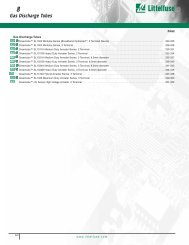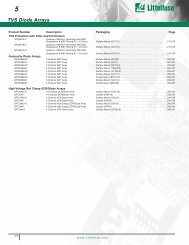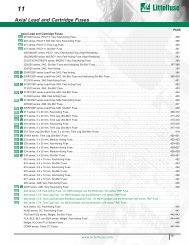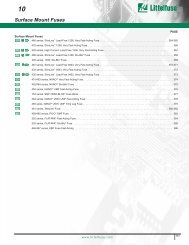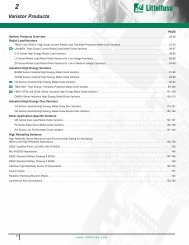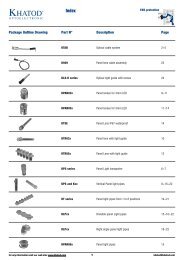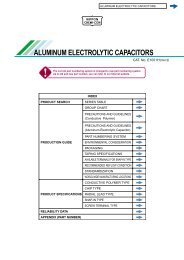Introduction to Circuit Protection
Introduction to Circuit Protection
Introduction to Circuit Protection
Create successful ePaper yourself
Turn your PDF publications into a flip-book with our unique Google optimized e-Paper software.
<strong>Introduction</strong> <strong>to</strong> <strong>Circuit</strong> <strong>Protection</strong><br />
Transien<strong>to</strong>logy<br />
Overvoltage Suppression Facts<br />
Maximum Non-Repetitive Surge Current (I TM )<br />
This is the maximum peak current which may be applied for an 8/20µs<br />
impulse, with rated line voltage also applied, without causing greater than<br />
10% shift in nominal voltage.<br />
Maximum Non-Repetitive Surge Energy (W TM )<br />
This is the maximum rated transient energy which may be dissipated for<br />
a single current pulse at a specified impulse and duration (2ms), with the<br />
rated V RMS applied, without causing device failure.<br />
Nominal Voltage (V N(DC) )<br />
This is the voltage at which the device changes from the off state <strong>to</strong><br />
the on state and enters its conduction mode of operation. This voltage<br />
is characterized at the 1mA point and has specified minimum and<br />
maximum voltage ratings.<br />
Clamping Voltage (V C )<br />
This is the peak voltage appearing across the MOV when measured at<br />
conditions of specified pulse current amplitude and specified waveform<br />
(8/20µs).<br />
Operating Temperature Range<br />
The minimum and maximum ambient operating temperature of the<br />
circuit in which the Varis<strong>to</strong>r will be applied, allowing for other adjacent<br />
components which could effect the surrounding temperature.<br />
Power Dissipation Ratings<br />
When transients occur in rapid succession the average power dissipation<br />
is the energy (watt-seconds) per pulse times the number of pulses per<br />
second. The power so developed must be within the specifications shown<br />
on the Device Ratings and Characteristics table for the specific device.<br />
Certain parameter ratings must be derated at high temperatures as<br />
shown in Figure 7.<br />
14<br />
PERCENT OF RATED VALUE<br />
100<br />
90<br />
80<br />
70<br />
60<br />
50<br />
40<br />
30<br />
20<br />
10<br />
ML, MLE, MHS, MLN<br />
CH,RA SERIES<br />
BA/BB, CA, DA/DB,<br />
LA, "C"III, HA, NA, MA,<br />
UltraMOV, PA, ZA SERIES<br />
0<br />
-55 50 60 70 80 90 100 110 120 130 140 150<br />
AMBIENT TEMPERATURE (ºC)<br />
Figure 7. Peak Current, Energy and Power Derating Curves<br />
www.littelfuse.com<br />
Voltage Clamping Device<br />
A clamping device, such as an MOV, refers <strong>to</strong> a characteristic in which<br />
the effective resistance changes from a high <strong>to</strong> low state as a function<br />
of applied voltage. In its conductive state, a voltage divider action is<br />
established between the clamping device and the source impedance<br />
of the circuit. Clamping devices are generally “dissipative” devices,<br />
converting much of the transient electrical energy <strong>to</strong> heat.<br />
PulseGuard ® Suppressors<br />
PulseGuard devices are designed for ESD transients. This technology<br />
is manufactured utilizing a polymer-over- gap procedure resulting in<br />
extremely low capacitance. Likewise, leakage current is essentially<br />
non-existent, an important fac<strong>to</strong>r for certain portable products.<br />
PulseGuard Suppressors, therefore, do not skew fast edge rates or<br />
attenuate high speed data signals due <strong>to</strong> capacitive loading. They are<br />
suited <strong>to</strong> data rate applications ranging beyond 5GHz. The PulseGuard<br />
family of devices are fabricated in various surface mount package<br />
devices as well as a D-Sub connec<strong>to</strong>r insert film. Like Multilayer<br />
Varis<strong>to</strong>rs, these devices are not applicable for existing safety agency<br />
standards listing. PulseGuard devices are intended for the suppression of<br />
Human Body Model ESD transients, such as defined in IEC 61000-4-2.<br />
TERMS<br />
Capacitance<br />
The capacitance measured between input pins and the common<br />
terminal, at 1 MHz.<br />
Leakage Current<br />
Until the PulseGuard suppressor transitions <strong>to</strong> the “on” state, it is<br />
electrically transparent <strong>to</strong> the circuit. Leakage current is specified at the<br />
rated voltage of the device.<br />
Voltage Rating<br />
PulseGuard suppressors are rated for use in operating environments up<br />
<strong>to</strong> 24 VDC.<br />
Temperature Rating<br />
The operating temperature range is –65°C <strong>to</strong> +125°C. Unlike the<br />
polymer PTCs, these devices do not operate as a result of thermal<br />
action; therefore, there is no rerating necessary.<br />
Agency Approvals<br />
At this time, there are no applicable standards for ESD suppressor<br />
components. Nonetheless, PulseGuard suppressors have been<br />
subjected <strong>to</strong> all levels of severity of the IEC 61000-4-2 test specification<br />
using both the Contact Discharge and Air Discharge injection methods.<br />
In all cases, clamping of the ESD transient is provided and the devices<br />
survived the multiple ESD events.<br />
Resistance<br />
While in the “off” state, the suppressors remain electrically transparent<br />
<strong>to</strong> the circuit. The measured resistance of the suppressors is 10 MΩ,<br />
or greater.




